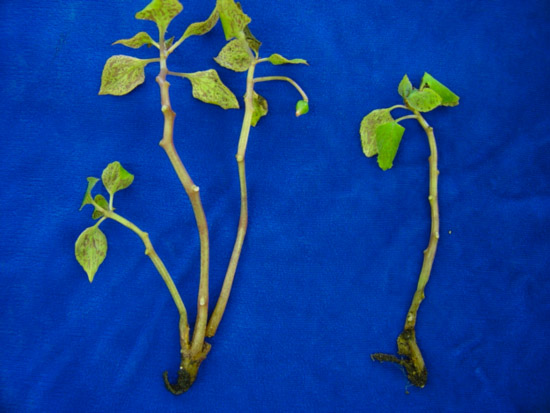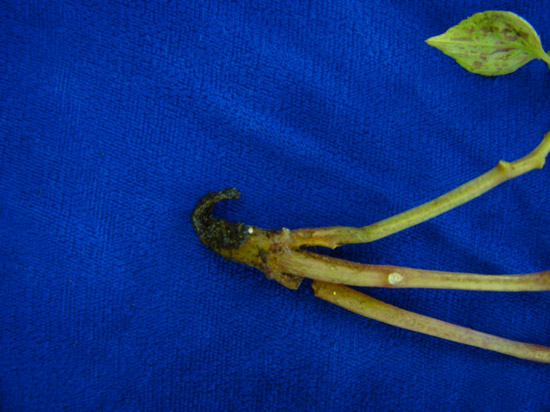Issue 13, July 30, 2012
Rhizoctonia Root Rot
When the ornamentals in your backyard are slowly dying off or developing poorly, this poor growth and decline may be symptoms of a Rhizoctonia root rot. Whether it is an ornamental, vegetable, or a field crop; a wide range of plants are subjected to Rhizoctonia root rot disease. The disease is caused by a soilborne fungus of the Rhizoctonia spp. Though a root rot pathogen, Rhizoctonia infections are not limited to roots. Other species of Rhizoctonia can extend their infection to the foliage and stems of the plants.
This pathogen is favored by warm, moderately wet environment, but can also infect without moisture. This disease is most prominent around midsummer, when conditions tend be hot and dry. Rhizoctonia has the ability to survive in the soil for long periods of time. Due to this fact, susceptible plants should not be planted in previously infected and problematic sites
Symptoms
Symptom expression of Rhizoctonia can vary depending on the severity of the disease and the susceptibility of the host. Some of the most common symptoms include poor growth, stunting, discoloration and wilting. The affected plant will appear less healthy, with smaller leaves and flowers. This is because the fungus disrupts the plant's root system, rendering the water transport ineffective. Sometimes discoloration can be observed on the stem near the soil line. Comparing the roots of a healthy plant to a diseased one will reveal brown, water-soaked roots on the diseased plant. When the seeds are infected, damping off can occur. Another way to confirm the plant is infected with root rot is to look at the infected tissue under the microscope. The fungus forms characteristic hyphae with 90-degree angled branching and constrictions near the branching points (second photo). The hyphae may or may not be pigmented. Rhizoctonia doesn't form any spores and spreads by forming a mycelial network that extends to nearby plants, which leads to further infection and colonization.

Rhizoctonia on impatiens.

Rhizoctonia hyphae under the microscope. Note the right angled hyphae along with septations near the branching points.

Aside from root rot, Rhizoctonia can also cause crown rot.
Management of the Disease
- Prevention and sanitation are the best ways to approach Rhizoctonia root rot control. Promptly remove any diseased plants and debris so that disease doesn't spread to nearby healthy plants.
- When purchasing plants, avoid unhealthy, diseased plants. Any heavily discounted bargain plants should be approached with caution as they may harbor diseases.
- Heat treatment can sometimes be used to kill the fungus in the soil.
- Proper soil drainage can also help to prevent disease development. If need be, organic matter can be added to assist with the drainage.
- Another suggestion is to rotate the plants every 2 to 3 years to prevent the Rhizoctonia fungus from building up.
- While fungicides are available, they do not necessarily kill or inhibit the growth of this pathogen. They are mostly only used as protectant for uninfected plants. It is best to check the labels of the fungicides carefully if you want to apply them.
If you suspect your plant has root rot disease, it is best to send it to the U of I Plant Clinic for identification or have a plant pathology expert inspect it to confirm the presence of Rhizoctonia. Other fungal pathogens such as Fusarium and Phytophthora or even environmental stress can cause similar symptoms. It is easy to misdiagnose the disease.
For more information, please consult web.aces.uiuc.edu/vista/pdf_pubs/615.pdf or hyg.ipm.illinois.edu/pastpest/200214c.html (Stephanie Porter and Zu Dienle Tan)
Authors:
Stephanie Porter
Zu Dienle Tan